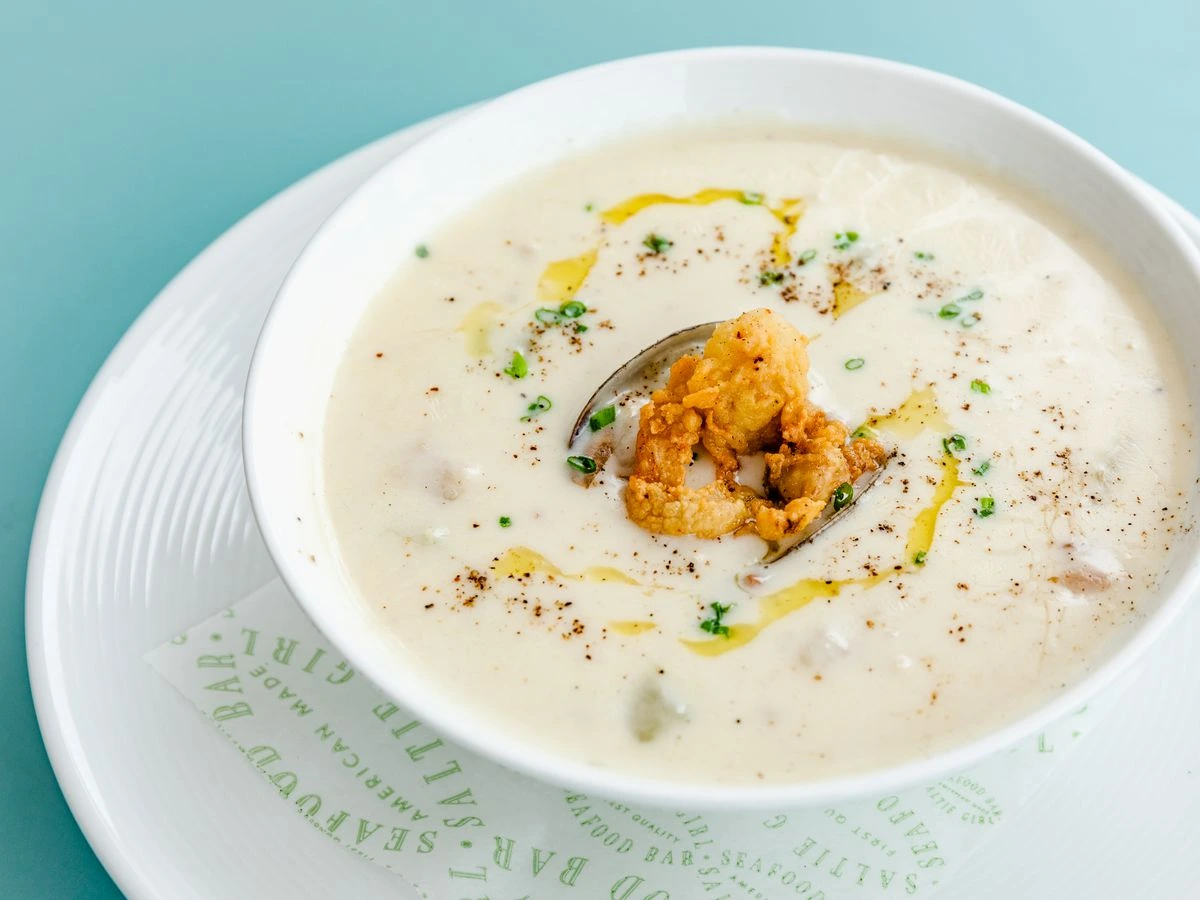
Clam chowder is a beloved dish that has become a staple in American cuisine, particularly in New England. Known for its creamy texture and rich flavors, this hearty soup features clams, potatoes, and a variety of seasonings. With a history rooted in coastal communities, clam chowder has evolved into various styles, each with its own unique twist. From its serving temperature to its nutritional benefits, clam chowder offers a delightful culinary experience that continues to capture the hearts and taste buds of many. Here are some interesting facts about this iconic dish.
Origin: Clam chowder is believed to have originated in the northeastern United States during the 18th century, particularly in New England. The dish’s roots can be traced back to the coastal communities where fishermen would prepare meals using freshly caught clams. The word “chowder” is thought to derive from the French word “chaudière,” referring to a pot used for cooking. As settlers from various regions brought their culinary traditions, clam chowder evolved into a signature dish of New England, reflecting the local seafood bounty and the influence of European cooking techniques.
Types: Clam chowder comes in several varieties, the most notable being New England clam chowder and Manhattan clam chowder. New England clam chowder is characterized by its creamy, rich base made from milk or cream, giving it a smooth texture and a white appearance. In contrast, Manhattan clam chowder features a tomato-based broth, which provides a tangy flavor and a red hue. Each type showcases the regional preferences and available ingredients, with New England chowder often served with a side of oyster crackers, while Manhattan chowder may be garnished with fresh herbs.
Ingredients: Traditional New England clam chowder typically includes key ingredients such as clams, potatoes, onions, and cream or milk. The clams are usually chopped and combined with other ingredients to create a hearty, flavorful soup. Potatoes add substance and texture, while onions provide an aromatic base. Many recipes also incorporate seasonings like thyme, bay leaves, and black pepper to enhance the overall flavor profile. The combination of these ingredients results in a comforting dish that has become a staple in New England cuisine.
National Clam Chowder Day: National Clam Chowder Day is celebrated on February 25th each year in the United States, honoring this beloved dish. This unofficial holiday invites clam chowder enthusiasts to indulge in their favorite variations, whether homemade or from local restaurants. Many seafood establishments take part in the celebration by offering special promotions or chowder tastings. It serves as a reminder of the cultural significance of clam chowder in American culinary history and encourages people to explore the diverse flavors and recipes associated with this classic dish.
Popularity: Clam chowder enjoys immense popularity in coastal regions of the United States, particularly in New England states such as Massachusetts, Maine, and Rhode Island. Its rich flavors and hearty ingredients make it a go-to comfort food, especially during the colder months. Many restaurants along the New England coast feature clam chowder as a signature dish, often served in bread bowls or alongside fresh seafood platters. The dish’s accessibility and adaptability have contributed to its widespread appeal, making it a favorite among locals and tourists alike.
Cans: The first canned clam chowder was produced by the Campbell Soup Company in the 1930s, marking a significant moment in the commercialization of this traditional dish. The introduction of canned clam chowder made it easier for consumers to enjoy this seafood delicacy without the need for extensive cooking. The convenience of canned soups revolutionized meal preparation, allowing busy households to quickly serve clam chowder as a satisfying meal option. Today, canned clam chowder remains a popular choice, with various brands and flavors available on grocery store shelves.
Weight: A standard serving of clam chowder is typically around 1 cup (approximately 240 ml) and can weigh about 240 grams. This serving size is commonly used in restaurants and home recipes, providing a hearty portion without overwhelming diners. The weight and volume of clam chowder can vary based on the recipe and additional ingredients, such as extra clams or vegetables. This serving size strikes a balance between being filling and allowing for a variety of accompaniments, such as bread or crackers, enhancing the overall dining experience.
Calories: A typical serving of New England clam chowder contains around 200-300 calories, depending on the specific recipe and ingredients used. This calorie range makes it a relatively moderate option for those seeking comfort food without excessive caloric intake. The nutritional content can vary significantly based on factors such as the amount of cream used, the inclusion of additional vegetables, and portion size. While clam chowder can be indulgent, it also offers a source of protein and essential nutrients from clams and potatoes, contributing to a balanced meal.
Clam Varieties: The most commonly used clams in chowder are quahog clams, also known as hard clams. Quahogs are favored for their firm texture and robust flavor, making them ideal for soups and chowders. These clams are harvested from the Atlantic Ocean, particularly in New England waters, and are available in various sizes, with larger clams often used for chowder. The choice of clams plays a crucial role in determining the overall flavor and texture of the chowder, as quahogs provide a briny sweetness that complements the creamy base. Additionally, other types of clams, such as littlenecks or cherrystones, can also be used, depending on regional preferences and availability. The freshness of the clams is essential, as it directly impacts the quality of the chowder, with freshly harvested clams yielding a more vibrant and authentic taste.
Record Bowl: The largest bowl of clam chowder was created in 2010 during a record-breaking event in Portland, Maine, weighing over 1,000 pounds. This impressive feat was part of a promotional effort to celebrate the city’s culinary heritage and the popularity of clam chowder in the region. The massive bowl was prepared by local chefs and featured a blend of traditional ingredients, showcasing the dish’s classic flavors on an unprecedented scale. This event not only highlighted the communal aspect of enjoying clam chowder but also drew attention to the local seafood industry and the importance of clams in the regional cuisine. The record-setting bowl served as a testament to the dish’s enduring popularity and its ability to bring communities together in celebration of their culinary traditions.
Historical References: The first known recipe for clam chowder appeared in “The Boston Cooking-School Cookbook” by Fannie Farmer in 1896. This cookbook played a significant role in American culinary history, as it was one of the first to standardize recipes and cooking techniques. Farmer’s recipe reflected the traditional New England style of clam chowder, emphasizing the use of fresh clams, potatoes, and cream. The publication of this cookbook helped popularize clam chowder beyond New England, introducing it to a wider audience and establishing it as a classic American dish. Fannie Farmer’s influence on American cooking continues to be felt today, as her approach to precise measurements and clear instructions revolutionized home cooking.
Cultural Significance: Clam chowder is a staple dish at many New England seafood shacks and restaurants, often serving as a symbol of the region’s rich maritime heritage. It embodies the local culture and culinary traditions, showcasing the abundance of seafood available along the Atlantic coast. Many seafood establishments take pride in their unique recipes, often passed down through generations. Clam chowder is frequently featured on menus, especially during the colder months when people seek comforting and hearty meals. Its presence at local festivals and events further cements its status as a beloved dish, reflecting the community’s connection to its coastal roots.
Chowder Festivals: The annual Newport Chowder Festival in Rhode Island is a highly anticipated event that celebrates various chowder recipes and culinary creativity. This festival draws both professional chefs and home cooks who compete for the title of “Best Chowder.” Attendees can sample a wide variety of chowder styles, from traditional New England to innovative twists that incorporate unique ingredients. The festival not only highlights the importance of clam chowder in local cuisine but also fosters community spirit and tourism. It has become a cultural event that showcases the culinary talents of the region while promoting the local seafood industry.
Variations: Other variations of clam chowder include Rhode Island clam chowder, which is characterized by its clear broth and absence of cream. This style of chowder uses a light, broth-based preparation that allows the natural flavors of the clams to shine through. It often includes ingredients such as tomatoes, vegetables, and herbs, providing a lighter alternative to the richer New England version. The clear broth is typically made from clam juice or stock, which enhances the dish’s seafood essence. This variation reflects the regional preferences and the diverse culinary influences present in New England, showcasing how clam chowder can be adapted to suit different tastes.
Clam Chowder in Literature: Clam chowder has made appearances in various works of literature, including the writings of author Herman Melville. In his famous novel “Moby-Dick,” Melville references clam chowder as part of the whaling culture and the maritime life of New England. Such literary mentions highlight the dish’s cultural significance and its role in the daily lives of those living near the coast. The inclusion of clam chowder in literature serves to reinforce its status as a quintessential New England dish, deeply rooted in the region’s history and identity.
Economic Impact: The clam industry is significant in New England, contributing millions of dollars annually to the economy. Clam harvesting supports numerous jobs, from fishermen to processors and distributors. The demand for clams, particularly quahogs, has led to sustainable fishing practices that ensure the longevity of clam populations. Local economies benefit from both commercial and recreational clam digging, with many towns hosting clam festivals and events that attract tourists. The economic impact of the clam industry underscores the importance of this seafood in supporting livelihoods and fostering community engagement in coastal regions.
Culinary Competitions: The International Chowder Festival in Rhode Island is another popular event that celebrates chowder in all its forms, drawing chefs and chowder enthusiasts from across the country. This festival features cooking competitions, tastings, and workshops focused on chowder preparation. Participants showcase their unique recipes, often incorporating innovative ingredients or techniques. The event not only promotes culinary creativity but also emphasizes the cultural significance of chowder as a dish that brings people together. It serves as a platform for culinary talent while encouraging the appreciation of traditional and modern interpretations of chowder.
Serving Temperature: Clam chowder is traditionally served hot, enhancing its comforting and hearty qualities. The warmth of the chowder is crucial, as it helps to release the rich flavors of the clams, potatoes, and seasonings. Often, it is accompanied by oyster crackers, which add a delightful crunch and can be used to scoop up the thick soup. The combination of hot chowder and crunchy crackers creates a satisfying dining experience, making it a popular choice in restaurants and homes alike, especially in colder months.
Shelf Life: The shelf life of clam chowder varies significantly between canned and homemade varieties. Canned clam chowder, when stored in a cool, dry place and unopened, can last for several years due to the preservation methods used during canning. However, once opened, it should be refrigerated and consumed within 3-4 days. Homemade clam chowder, while often fresher and more flavorful, is best enjoyed shortly after preparation. This short shelf life is due to the lack of preservatives and the perishable nature of its ingredients, particularly dairy and seafood.
Record Sales: In 2019, the clam chowder market in the United States was valued at approximately $250 million, showcasing its popularity among consumers. This figure reflects the demand for both canned and fresh versions of the dish, highlighting its status as a staple in American cuisine, particularly in New England. The market encompasses various brands and styles, including traditional New England clam chowder, which is cream-based, and Manhattan clam chowder, which features a tomato base. The significant market value indicates the dish’s cultural importance and its widespread appeal across different demographics.
Culinary Techniques: Traditional clam chowder is often thickened using a roux, which is a mixture of flour and fat, usually butter. This technique is essential for achieving the desired creamy texture that characterizes clam chowder. The roux is cooked to a light golden color before adding liquids like clam juice and cream, allowing it to develop a rich flavor. The addition of diced potatoes and clams creates a hearty dish that is both filling and flavorful. Mastering the roux is a fundamental skill in creating a successful chowder, as it serves as the foundation for the dish’s consistency and taste.
Nutrition: Clam chowder is a source of protein, providing around 10 grams per serving, making it a nutritious option for those seeking to incorporate seafood into their diet. Clams are not only rich in protein but also provide essential nutrients such as vitamin B12, iron, and omega-3 fatty acids. While clam chowder can be higher in calories and fat due to the cream and butter commonly used in recipes, it can be part of a balanced diet when enjoyed in moderation. The inclusion of potatoes and vegetables also adds fiber, contributing to the overall nutritional profile of the dish.
Famous Brands: Popular brands of clam chowder, such as Campbell’s and Progresso, have made the dish accessible to a wide audience through their canned offerings. These brands have established themselves in the market by providing convenient, ready-to-eat options that maintain the classic flavors of clam chowder. Campbell’s, known for its iconic red and white can, offers a traditional New England clam chowder, while Progresso provides a variety of flavors and styles. The availability of these canned versions allows consumers to enjoy clam chowder at home without the need for extensive preparation, appealing to busy lifestyles.
Cultural Events: The Chowder Cook-Off in Monterey, California, is a celebrated event that showcases the culinary creativity surrounding clam chowder. This annual festival attracts chefs and food enthusiasts from various regions, all competing for the title of best chowder. Attendees have the opportunity to sample a wide range of chowder styles, from traditional recipes to innovative twists, reflecting the dish’s versatility. The event not only highlights clam chowder’s popularity but also fosters a sense of community and appreciation for local seafood and culinary traditions.
Clam Chowder in Movies: Clam chowder has made notable appearances in films, often symbolizing New England cuisine and culture. Its depiction in movies can evoke a sense of nostalgia and comfort, representing the coastal lifestyle and culinary heritage of the region. Films that feature clam chowder may highlight its role in family gatherings, local festivals, or as a beloved dish in restaurants, further embedding it into the cultural narrative. These portrayals contribute to the dish’s iconic status, making it a recognizable and cherished element of American culinary identity.
Clam Chowder FAQs
General Questions
1. What is clam chowder?
- Clam chowder is a hearty soup or stew made with clams, potatoes, and a creamy base. It’s a classic American dish, particularly popular in coastal regions.
2. What are the main ingredients in clam chowder?
- The primary ingredients in clam chowder are clams, potatoes, cream (or milk), butter, and flour. Other common ingredients may include bacon, onions, celery, and herbs like thyme or bay leaves.
3. What is the difference between New England clam chowder and Manhattan clam chowder?
- The two main types of clam chowder are New England and Manhattan. New England clam chowder is creamy and white, made with milk or cream, while Manhattan clam chowder is red and tomato-based.
4. Where did clam chowder originate?
- The exact origin of clam chowder is debated, but it is believed to have developed in coastal regions of North America, likely in the 17th or 18th century.
Preparation and Serving
1. How is clam chowder typically served?
- Clam chowder is often served hot and steaming, in a bowl or a bread bowl. It’s a popular dish for cold weather and is often accompanied by crackers or crusty bread.
2. Can I make clam chowder at home?
- Yes, you can definitely make clam chowder at home. There are many recipes available online and in cookbooks. The key is to use fresh or high-quality canned clams and to simmer the chowder until the flavors have melded together.
3. How long does it take to make clam chowder?
- The preparation time for clam chowder can vary depending on the recipe and the ingredients used. However, it generally takes 30-45 minutes to cook.
4. Can I freeze clam chowder?
- Yes, you can freeze clam chowder for later. It is best to freeze it in airtight containers or freezer bags. When reheating, be sure to thaw it in the refrigerator overnight and then simmer it gently until heated through.
Variations and Substitutions
1. Can I use different types of clams for clam chowder?
- Yes, you can use different types of clams for clam chowder, but the most common choices are littleneck clams and quahogs. Other options include clams in brine or canned clams.
2. Can I substitute milk for cream in clam chowder?
- Yes, you can substitute milk for cream in clam chowder. However, the creaminess and richness of the chowder may be slightly different.
3. Can I add vegetables or other ingredients to clam chowder?
- Yes, you can add vegetables or other ingredients to clam chowder. Common additions include corn, peas, bacon, and herbs.
4. Can I make clam chowder vegetarian or vegan?
- Yes, you can make clam chowder vegetarian or vegan by using vegetable broth instead of clam broth and substituting the dairy products with plant-based alternatives.








